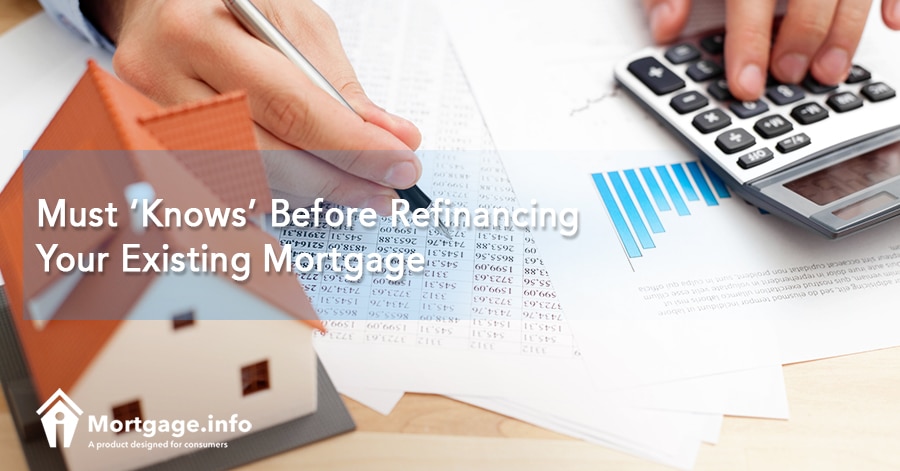Refinancing seems to make sense in any situation. Who wouldn’t want to get a lower payment, right? While it sounds good in a perfect world, there are certain times when it doesn’t make sense to do so. We’ll show you how to figure out your break-even point and learn what refinancing does to your loan.
Compare Offers from Several Mortgage Lenders.
Knowing these important facts before you refinance can help you make the most of the process and limit the number of times you change your loan.
You’ll Need Home Equity
If you are refinancing a conventional or subprime loan, you’ll need equity in your home in order to refinance. The exact amount you will need depends on the loan program you choose. The higher your equity, the lower the rate lenders usually charge because the risk of default goes down with higher equity.
The only exception to the rule is if you have a government-backed loan, such as the FHA or VA loan. These loan programs have streamlined refinance options that don’t require lenders to verify the value of your property. The lender can refinance your loan even if you are upside down on your mortgage. This is a good option for borrowers that want to get a lower payment but know they don’t have any equity in their home.
You’ll Need to Know Your Break-Even Point
Your break-even point is when you pay off the cost of the refinance and start reaping the savings. The closing costs on the average refinance can cost between 2% and 5% of your loan amount. Let’s say you have a $250,000 loan. It could cost you as much as $12,500 in closing costs. If your new loan only saves you $50 per month, it will take you 250 months to ‘break-even.’ It probably would not make sense to do so.
Only you will know what break-even point is right for you. We recommend focusing on loans that will help you break-even in five years or less to make it worth it. But, if you know you will move in less than five years, your break-even point would obviously be shorter.
You can figure out your break-even point with the following equation:
Total closing costs/Monthly savings with new loan = Break-even Point
You Start Your Term Over When you Refinance
Unless you are lucky enough to refinance into a loan with a shorter term, you restart the clock on your loan. Let’s say you have a 30-year loan now and have already paid five years on the loan. You want to lower the rate on your loan so you take out a new 30-year loan. You just lost the five years that you paid. Yes, your principal balance is less, hopefully, but you still pay interest for another 30 years, making the total years you pay interest on a loan 35 years rather than 30 years.
Click to See the Latest Mortgage Rates.
When you restart your loan, you also pay a heavy amount of interest each month compared to the principal. This occurs for the first few years of any mortgage. You can see just how much interest you would pay versus the principal on the amortization table. You can compare this to your current amortization table to see if the refinance is worth it.
You May be Able to Eliminate PMI
If you pay PMI now but know your home appreciated in value, you may be able to get rid of the PMI with a refinance. This only works on conventional loan refinances, though. FHA loans require mortgage insurance for the life of the loan no matter the LTV.
In order to eliminate PMI, you’ll have to determine if your principal balance is less than 80% of the new appraised value. If it’s close, but slightly over, you could pay the difference at the closing to make sure that you are at or below 80% to avoid this extra fee on your mortgage payment.
Refinancing to eliminate PMI is a common occurrence and can save you several hundred dollars per month. This is especially helpful if your lender doesn’t allow PMI removal without a refinance.
You Aren’t Entitled to a Lower Rate
Don’t assume a lender has to give you the low refinance rate they advertise. You have to qualify for the loan. In other words, you need to meet the credit score, debt ratio, and LTV requirements the lender has. If you don’t, it doesn’t mean they won’t approve you, but it might not be for the ‘good’ interest rate you were trying to get.
If you can prove to a lender that you deserve the low-interest rate, though, you may get it. Try to maximize your credit score and lower your debt ratio. A higher amount of equity in the home can help too. The less risk the lender feels that you pose, the better your chances of saving with a refinance.
Refinancing can be a great way to save money and get ahead on your home investment, but you have to make sure all of the pieces of the puzzle come together. Work on your qualifying factors before you apply for the refinance to make sure you get the best deals offered to you.

